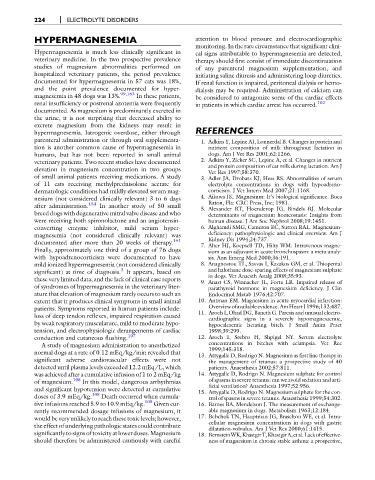Page 234 - Fluid, Electrolyte, and Acid-Base Disorders in Small Animal Practice
P. 234
224 ELECTROLYTE DISORDERS
HYPERMAGNESEMIA attention to blood pressure and electrocardiographic
monitoring. In the rare circumstance that significant clini-
Hypermagnesemia is much less clinically significant in cal signs attributable to hypermagnesemia are detected,
veterinary medicine. In the two prospective prevalence therapy should first consist of immediate discontinuation
studies of magnesium abnormalities performed on of any parenteral magnesium supplementation, and
hospitalized veterinary patients, the period prevalence initiating saline diuresis and administering loop diuretics.
documented for hypermagnesemia in 57 cats was 18%, If renal function is impaired, peritoneal dialysis or hemo-
and the point prevalence documented for hyper- dialysis may be required. Administration of calcium can
magnesemia in 48 dogs was 13%. 99,163 In these patients, be considered to antagonize some of the cardiac effects
renal insufficiency or postrenal azotemia were frequently in patients in which cardiac arrest has occurred. 102
documented. As magnesium is predominantly excreted in
the urine, it is not surprising that decreased ability to
excrete magnesium from the kidneys may result in
hypermagnesemia. Iatrogenic overdose, either through REFERENCES
parenteral administration or through oral supplementa- 1. Adkins Y, Lepine AJ, Lonnerdal B. Changes in protein and
tion is another common cause of hypermagnesemia in nutrient composition of milk throughout lactation in
humans, but has not been reported in small animal dogs. Am J Vet Res 2001;62:1266.
veterinary patients. Two recent studies have documented 2. Adkins Y, Zicker SC, Lepine A, et al. Changes in nutrient
and protein composition of cat milk during lactation. Am J
elevation in magnesium concentration in two groups
Vet Res 1997;58:370.
of small animal patients receiving medications. A study 3. Adler JA, Drobatz KJ, Hess RS. Abnormalities of serum
of 11 cats receiving methylprednisolone acetate for electrolyte concentrations in dogs with hypoadreno-
dermatologic conditions had mildly elevated serum mag- corticism. J Vet Intern Med 2007;21:1168.
nesium (not considered clinically relevant) 3 to 6 days 4. Aikawa JK. Magnesium: It’s biological significance. Boca
after administration. 154 In another study of 50 small Raton, Fla: CRC Press, Inc; 1981.
5. Alexander RT, Hoenderop JG, Bindels RJ. Molecular
breed dogs with degenerative mitral valve disease and who determinants of magnesium homeostasis: Insights from
were receiving both spironolactone and an angiotensin- human disease. J Am Soc Nephrol 2008;19:1451.
converting enzyme inhibitor, mild serum hyper- 6. Alghamdi SMG, Cameron EC, Sutton RAL. Magnesium-
magnesemia (not considered clinically relevant) was deficiency: pathophysiologic and clinical overview. Am J
Kidney Dis 1994;24:737.
documented after more than 20 weeks of therapy. 161
7. Alter HJ, Koepsell TD, Hilty WM. Intravenous magne-
Finally, approximately one third of a group of 76 dogs sium as an adjuvant in acute bronchospasm: a meta-analy-
with hypoadrenocorticism were documented to have sis. Ann Emerg Med 2000;36:191.
mild ionized hypermagnesemia (not considered clinically 8. Anagnostou TL, Savvas I, Kazakos GM, et al. Thiopental
3 and halothane dose-sparing effects of magnesium sulphate
significant) at time of diagnosis. It appears, based on
in dogs. Vet Anaesth Analg 2008;35:93.
these very limited data, and the lack of clinical case reports 9. Anast CS, Winnacker JL, Forte LR. Impaired release of
of syndromes of hypermagnesemia in the veterinary liter- parathyroid hormone in magnesium deficiency. J Clin
ature that elevation of magnesium rarely occurs to such an Endocrinol Metab 1976;42:707.
extent that it produces clinical symptoms in small animal 10. Antman EM. Magnesium in acute myocardial infarction:
patients. Symptoms reported in human patients include: Overviewofavailableevidence.AmHeartJ1996;132:487.
11. Aroch I, Ohad DG, Baneth G. Paresis and unusual electro-
loss of deep tendon reflexes, impaired respiration caused
cardiographic signs in a severely hypomagnesaemic,
by weak respiratory musculature, mild to moderate hypo- hypocalcaemic lactating bitch. J Small Anim Pract
tension, and electrophysiologic derangements of cardiac 1998;39:299.
conduction and cutaneous flushing. 107 12. Aroch I, Srebro H, Shpigel NY. Serum electrolyte
A study of magnesium administration to anesthetized concentrations in bitches with eclampsia. Vet Rec
1999;145:318.
normal dogs at a rate of 0.12 mEq/kg/min revealed that
13. Attygalle D, Rodrigo N. Magnesium as first line therapy in
significant adverse cardiovascular effects were not the management of tetanus: a prospective study of 40
detected until plasma levels exceeded 12.2 mEq/L, which patients. Anaesthesia 2002;57:811.
was achieved after a cumulative infusion of 1 to 2 mEq/kg 14. Attygalle D, Rodrigo N. Magnesium sulphate for control
of magnesium. 108 In this model, dangerous arrhythmias of spasms in severe tetanus: can we avoid sedation and arti-
ficial ventilation? Anaesthesia 1997;52:956.
and significant hypotension were detected at cumulative 15. Attygalle D, Rodrigo N. Magnesium sulphate for the con-
doses of 3.9 mEq/kg. 108 Death occurred when cumula- trol of spasms in severe tetanus. Anaesthesia 1999;54:302.
tive infusions reached 5.9 to 10.9 mEq/kg. 108 Given cur- 16. Barnes BA, Mendelson J. The measurement of exchange-
rently recommended dosage infusions of magnesium, it able magnesium in dogs. Metabolism 1963;12:184.
wouldbe very unlikely to reach these toxic levels; however, 17. Bebchuk TN, Hauptman JG, Braselton WE, et al. Intra-
cellular magnesium concentrations in dogs with gastric
the effect of underlying pathologic states could contribute
dilatation-volvulus. Am J Vet Res 2000;61:1415.
significantly to signs oftoxicity atlowerdoses. Magnesium 18. BernsteinWK,KhastgirT,KhastgirA,etal.Lackofeffective-
should therefore be administered cautiously with careful ness of magnesium in chronic stable asthma: a prospective,

